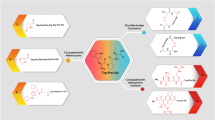GnRH analogues have been extensively used in oncology to induce reversible chemical castration due to their hypophysiotropic action. In addition to that, it has recently been shown that many malignant cells, such as breast cancer cells, locally produce GnRH and express the GnRH receptor/s. In order to investigate the structure-activity relationships in both pituitary and extrapituitary biological systems, we synthesized eight new GnRH analogues with modifications in the N-terminal part and/or in position 6 and studied their pituitary binding affinity (in αT3-1 cell membranes) and effect on breast cancer (MCF-7) cell proliferation. 2-Amino-4-pyrrolidinothieno[2,3-d]pyrimidine-6-carboxylic acid (ATPC) was incorporated instead of pGlu1-His2- and/or Gly6 was substituted by α-aminoisobutyric acid, D-Leu and D-Lys (alone or covalently linked to Gly, Ala, Sar, ATPC). Most GnRH analogues lacked the carboxy-terminal Gly10-amide of GnRH and an ethylamide residue was added to Pro9, a modification common in many potent GnRH agonists, such as leuprolide ([D-Leu6, des-Gly10]-GnRH-NHEt. Results show differential impact of these modifications on the binding affinity to the GnRH receptor in mouse pituitary cells and on the inhibition of human breast cancer cell proliferation. ATPC in the N-terminus resulted in analogues with low binding affinity but high antiproliferative effect. Substitutions in position 6 always resulted in high binding affinities. In particular, [D-Lys6(Gly), desGly10]-GnRH-NHEt and [D-Lys6(Sar), desGly10]-GnRH-NHEt have higher pituitary binding affinity than leuprolide, but only the latter had significant antiproliferative effect on both MCF-7 and MDA-MB-231 cells. These results contribute to the on-going research for more potent GnRH analogues.



Similar content being viewed by others
Abbreviations
- GnRH:
-
gonadotropin releasing hormone (or LHRH, luteinizing hormone releasing hormone)
- ATPC:
-
2-amino-4-pyrrolidinothieno[2,3-d]pyrimidine-6-carboxylic acid
- Aib:
-
α-aminoisobutyric acid
- DIC:
-
N,N′-diisopropylcarbodiimide
- DMF:
-
N,N′-dimethylformamide
- TFA:
-
trifluoroacetic acid
- HPLC:
-
high-performance liquid chromatography
- FBS:
-
fetal bovine serum
- IC50 :
-
concentration of tested compound required to inhibit 50% of specific binding of the radioligand during competition
References
Amoss M., Burgus R., Blackwell R., Vale W., Fellows R., Guillemin R. (1971) Biochem. Biophys. Res. Commun. 44, 205–210
Barlos K., Chatzi O., Gatos D., Stavropoulos G. (1991) Int. J. Pept. Protein Res. 37, 513–520
Bernatowitz M. S., Daniels S. B., Köster H. (1989) Tetrahedron Lett. 30, 4645–4648
Bissyris E. E., Belekos D., Magafa V., Tsoungas P. G., Varvounis G., Cordopatis P. (2005) Synthesis 18, 3159–3166
Blankenstein M. A., Henkelman M. S., Klijn J. G. M. (1985) Eur. J. Cancer Clin. Oncol. 21, 1493–1499
Carpino L. A., Han G. Y. (1972) J. Org. Chem. 37, 3404–3409
Chen A., Kaganovsky E., Rahimipour S., Ben-Aroya N., Okon E., Koch Y. (2002) Cancer Res. 62, 1036–1044
Chhabra S. R., Hothi B., Evans D. J., White P. D., Bycroft B. W., Chan W. C. (1998) Tetrahedron Lett. 39, 1603–1606
Eidne K. A., Flanagan C. A., Millar R. P. (1985) Science 229, 989–991
Emons G., Schally A. V. (1994) Hum. Reprod. 9, 1364–1379
Emons G., Müller V., Ortmann O., Grossmann G., Trautner U. von Stuckrad B., Schally A. V. (1996) Int. J. Oncol. 9, 1129–1137
Emons G., Ortmann O., Schulz K. D., Schally A. V. (1997) Trends Endocrinol. Metab. 8, 355–362
Estep K. G., Neipp C. E., Stephens Stramiello L. M., Adam M. D., Allen M. P., Robinson S., Roskamp E. J. (1998) J. Org. Chem. 63, 5300–5301
Fekete M., Wittliff J. L., Schally A. V. (1989) J. Clin. Lab. Anal. 3, 137–147
Fujino M., Kobayashi S., Obayashi M., Shinagawa S., Fukuda T. (1972) Biochem. Biophys. Res. Commun. 49, 863–869
Grundker C., Volker P., Emons G. (2001) Endocrinology 142, 2369–2380
Huirne J. A., Lambalk C. B. (2001) Lancet 358, 1793–1803
Kahan Z., Nagy A., Schally A. V., Halmos G., Arencibia J. M., Groot K. (2000) Breast. Cancer. Res. Treat. 59, 255–262
Kakar S. S., Grizzle W. E., Neill J. D. (1994) Mol Cell Endocrinol 106, 145–149
Kousidou O. C., Mitropoulou T. N., Roussidis A. E., Kletsas D., Theocharis A. D., Karamanos N. K. (2005) Int. J. Oncol. 26, 1101–1109
Limonta P., Moretti R. M., Marelli M. M., Motta M. (2003) Front. Neuroendocrinol. 24, 279–295
Matsuo H., Baba Y., Nair R. M. G., Arimura A., Schally A. V. (1971) Biochem. Biophys. Res. Commun. 43, 1334–1339
Millar R. P., Lu Z. L., Pawson A. J., Flanagan C. A., Morgan K., Maudsley S. R. (2004) Endocr. Rev. 25, 235–275
Miller W. R., Scott W. N., Morris R., Fraser H. M., Sharpe R. M. (1985) Nature 313, 231–233
Mitropoulou T. N., Tzanakakis G. N., Kletsas D., Kalofonos H. P., Karamanos N. K. (2003) Int. J. Cancer 104, 155–160
Mosmann T. (1983) J. Immunol. Methods 65, 55–63
Raynor K., Reisine T. (1989) J. Pharmacol. Exp. Ther. 251, 510–517
Sealfon S. C., Weinstein H., Millar R. P. (1997) Endocr. Rev. 18, 180–205
Segal-Abramson T., Kitroser H., Levy J., Schally A. V., Sharoni Y. (1992) Proc. Natl. Acad. Sci. USA 89, 2336–2339
Vojkovsky T. (1995) Pept. Res. 8, 236–237
Windle J., Weiner R., Mellon P. (1990) Mol. Endocrinol. 4, 597–603
Zompra A. A., Magafa V., Lamari F. N., Nikolopoulou A., Nock B., Maina T., Spyroulias G. A., Karamanos N. K., Cordopatis P. (2005) J .Pept. Res. 66(s.1), 57–64
Acknowledgments
We acknowledge funding from EPAN programme of the 3rd Community Support Framework, Health, Biomedicine, Diagnostic and Therapeutic Methods’ (Ministry of Development, General Secretariat of Research and Technology, Greece). We thank Prof. Pamela Mellon for providing αT3-1 cells (School of Medicine, University of California, San Diego, CA).
Author information
Authors and Affiliations
Corresponding author
Additional information
Abbreviations of common amino acids are in accordance with the recommendations of IUPAC-IUB Joint Commission on Biochemical Nomenclature: Arch. Biochem. Biophys. 206, pp.v-xxii (1988), J. Biol. Chem. 264, 668–673 (1989) or J. Peptide Sci. 9, 1–8 (2003).
Rights and permissions
About this article
Cite this article
Zompra, A.A., Magafa, V., Chryssanthi, D.G. et al. Synthesis and Biological Evaluation of New GnRH Analogues on Pituitary and Breast Cancer Cells. Int J Pept Res Ther 13, 143–149 (2007). https://doi.org/10.1007/s10989-006-9057-9
Received:
Accepted:
Published:
Issue Date:
DOI: https://doi.org/10.1007/s10989-006-9057-9




